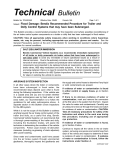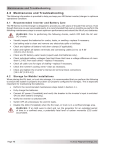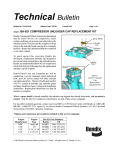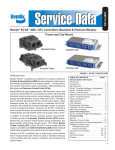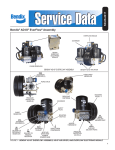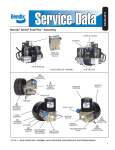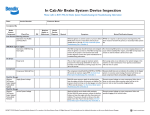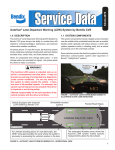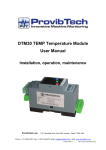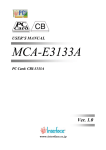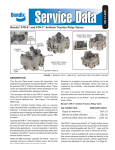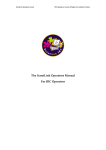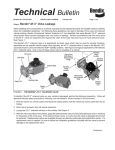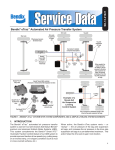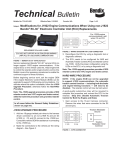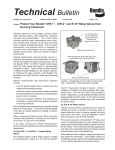Download BENDIX TCH-003-049A User's Manual
Transcript
Technical Bulletin Bulletin No: TCH-003-049 Subject: Effective Date: 10/18/05 Cancels: N/A Page: 1 of 4 Flood Damage: Bendix Recommended Procedure for Power Vehicles that may have been Submerged. This Bulletin provides a recommended procedure for the inspection and (where possible) reconditioning of the air brake control system components on power vehicles (Trucks, Tractors, and Buses) that have been submerged in flood waters. See Bulletin TCH-003-048 for Trailer and Dolly recommended inspections. CAUTION: Take all appropriate safety measures when working in conditions where hazardous waste, etc. may be present, including appropriate eye protection, gloves and masks. See the General Precautions section at the end of this Bulletin for recommended standard maintenance safety practices for normal conditions. SALT (SEA) WATER IMMERSION Bendix Commercial Vehicle Systems LLC recommends immediate replacement of all power vehicle pneumatic air brake valves that have been submerged in salt (sea) water to avoid any immediate or future operational issues as a result of internal corrosion. Due to the extremely corrosive nature of salt water and the inherent removal of valve lubrication, sudden and premature valve malfunction can result. Vehicle components recommended to be replaced include air compressors, reservoir(s), relay valves, spring brake valves, ABS relay-modulators and brake actuators. If the air brake components are being replaced, there is no need to conduct the Air Brake System Inspections below, instead go to the sections for ABS System inspections and also the “General” heading for steps in restoring the vehicle to service. AIR BRAKE SYSTEM INSPECTION In all other cases where the power vehicle or components have been submerged in fresh water, the recommended steps depend upon what is found during the following inspections. If the vehicle was in a coastal area and you are not certain whether the water submergence was by fresh water or salt (sea) water, our recommendation is to follow the guidelines for salt water submergence above. A separate section in this Bulletin covers inspections for the ABS system. While it is not the scope of this Bulletin to address anything beyond the air brake control system of the power vehicle, as a useful first step, Bendix Commercial Vehicle Systems LLC recommends that a thorough power-washing of the power vehicle, including the foundation brakes, will assist the technician in determining the condition of the vehicle components. Follow usual chassis re-lubrication measures (including re-greasing of slack adjusters) after power-washing. To check for evidence of water or contamination, mark and remove the connectors at the first valve in the system from the front. Inspect the valve for water and contaminants. Carefully use air pressure to blow air through the hoses and watch for evidence of water or contamination. CAUTION: Take all necessary precautions for safety of the technician and others in the work area during this procedure, including use of appropriate eye protection. If evidence of water or contamination is found, go to Section A below. Continue to inspect all the valves in the air brake system, removing one control (or supply in the case of quick release valves) and delivery hose from each of the valves and inspect to determine if there is evidence of water or contamination. If evidence of water or contamination is found, follow the instructions under Section A. If no evidence of water or contamination is found in any of the valves or hoses, follow the braking system inspections shown in Section B. continued over Bulletin No: TCH-003-049 Effective Date: 10/18/05 Cancels: N/A Page: 2 of 4 Section A. Power vehicle air brake systems with evidence of water or contamination heater for operation for models where it is not part of the purge valve assembly and replace as needed. Once water or contamination has entered into any of the air brake components (for example through the exhaust valves, etc.), removal of all the water or contamination is not possible without total disassembly of the components. Therefore Bendix recommends that all pneumatic air brake components be replaced (including the air compressor, air dryer, reservoir(s), relay valves, spring brake valves, ABS relay-modulators, tractor protection valves and brake actuators). This action is necessary to avoid any immediate or future operational issues as a result of internal corrosion and water migration. For ABS system checks, see “ABS Systems” section below. Vehicles with normally-functioning air brake systems can be returned to service. Have all air dryers regularly serviced to aid in removing any residual moisture from the vehicle air brake system. See the “ABS Systems” section below for ABS system checks and the “General” subheading below for hose cleaning/replacement recommendations. Section B. Power vehicle air brake system with no evidence of water/contaminants found. Power vehicles with only limited exterior exposure to fresh water can be returned to service after having their air brake system thoroughly tested. Include checks to verify that the parking and emergency brakes apply and release and that the reservoirs charge with minimal leakage (See General section at the end of this Bulletin for details of a leakage test). Check that the application and release of the power vehicle service and parking brakes occur with no perceptible lag through the full range of normal service brake applications. Where applicable (for towing vehicles), make certain that the trailer supply and trailer service glad hands apply and release the trailer brakes fully with no perceptible lag. In addition, all reservoirs should be pressurized and then slowly drained using their drain valves to remove any contents. After 30 days retest the vehicle (see next section). 30 DAY RETEST Bendix recommends that power vehicles that do not show any internal evidence of water or contamination be retested 30 days after the vehicle has been returned to service. Bendix recommends that the vehicle be re-tested for operation, leakage, and contamination, and that a diagnostic check of the ABS system be carried out (see below). Use diagnostic software (e.g. Bendix ® ACom5 ™ PC-Diagnostic Software) to look for any present or intermittent trouble codes stored in the ABS ECU. Any air brake components found inoperative should be replaced. ABS SYSTEMS ABS systems on power vehicles are comprised of an ABS wire harness, wheel speed sensors, and an Electronic Control Unit (ECU) — in some cases with an attached relay/modulator valve assembly (see above for air brake valve inspections). With a parked vehicle (chocked wheels), test the Tractor Protection function by disconnecting the service glad hand. Caution: Have a technician hold the tractor service glad hand to prevent damage as a result of the test - since it may whip. With the red Trailer Air Supply button in, make a service brake application. The tractor protection function should detect that the glad hand is unattached, and pop the red button out, protecting the tractor from further air loss through the glad hand. FRAME-MOUNT ECUS Replace any non-functioning valves. Following the thorough cleaning of the air dryer it is recommended to service the unit by replacing the purge valve assembly and desiccant cartridge irrespective of the level of contamination found, as long as the housing is not physically damaged. Check the CAB-MOUNT ECU FIGURE 1 - EXAMPLES OF BENDIX FRAME AND CABMOUNT ECUS Bulletin No: TCH-003-049 Effective Date: 10/18/05 ABS System Physical Inspection. Inspect ABS harnesses for damage, cuts, chafing, etc. and replace as necessary (Bendix does not recommend repairing or splicing harnesses). Since the action of floodwaters and power-washing may move the ABS wheel speed sensors from their normal position close to the exciter (tone) ring, push (by hand) each of the wheel speed sensors until they contact the exciter ring. Normal wheel bearing play will adjust the sensor position when the wheel turns. When replacing ABS wheel speed sensors, either because of damage, or as a result of electronic diagnostic checks (see below), follow carefully the lubrication and re-installation instructions in the instruction sheet that is included with the replacement sensor (or, if available, you may use BW-120-A). Whenever a wheel speed sensor is removed from its mounting block, Bendix recommends that the sensor clip be replaced. ABS System Electronic Inspection. One of two types of Bendix ECU styles may be used on the power vehicle: frame-mount or cab-mount. See below Figure 1. All cab-mounted ECUs that have been submerged must be replaced. Unless damaged, frame-mounted ECUs are normally “weatherproof” and are not affected by water or most types of contamination. Attach the power vehicle to a towed vehicle and power up the system. Note any ABS indicator lamp diagnostic codes - verify PLC communication between the trailer and tractor. As necessary, use diagnostic software (e.g. Bendix® ACom5™ PC-Diagnostic Software) to look for any present or intermittent trouble code history stored in the ECU. Replace components as necessary. Cancels: N/A Page: 3 of 4 If the contamination cannot be removed from an air line in this manner, replace the air line using SAE approved materials. Air Brake System and Accessory Leakage Test Park the vehicle on level ground and chock the wheels. Build system pressure to governor cut-out and allow the pressure to stabilize for one minute. Step 1: Observe the dash gauges for two additional minutes without the service brakes applied. Step 2: Release the parking brakes, and apply the service brakes. Allow the pressure to stabilize. Continue holding for two minutes (you may use a block of wood to hold the pedal in position.) Observe the dash gauges. If you see any noticeable decrease of the dash air gauge readings (i.e. more than 4 psi, plus two psi for each additional trailer) during either two minute test, repair the leaks and repeat this test to confirm that they have been repaired. For more information, see Bendix air leakage video BW2322(DVD), BW2324(VHS), or BW2327(CD). Bendix Technical Assistance Team For direct telephone technical support, call the Bendix technical assistance team at: 1-800-AIR-BRAKE (1-800-247-2725-2-1), Monday through Friday, 8:00 A.M. to 6:00 P.M. EST, and follow the instructions in the recorded message. Or, you may e-mail the Bendix technical assistance team at: [email protected]. See BW1396 for further dual circuit brake system troubleshooting tests. GENERAL Bendix recommends that standard operator pretrip inspections to ensure proper air brake system operation be rigorously performed for all vehicles potentially impacted by flood conditions. When replacing pneumatic system components that have been subjected to flood conditions, Bendix recommends that all contaminated air hoses be disconnected and flushed with clean water and blown out with air pressure to remove contaminants. CAUTION: Take all necessary precautions for safety of the technician and others in the work area during this procedure, including eye protection. See over for General Precautions. Bulletin No: TCH-003-049 Effective Date: 10/18/05 General Precautions. WARNING! PLEASE READ AND FOLLOW THESE INSTRUCTIONS TO AVOID PERSONAL INJURY OR DEATH: When working on or around a vehicle, the following general precautions should be observed at all times. 1. 2. 3. 4. Park the vehicle on a level surface, apply the parking brakes, and always block the wheels. Always wear safety glasses. Stop the engine and remove ignition key when working under or around the vehicle. When working in the engine compartment, the engine should be shut off and the ignition key should be removed. Where circumstances require that the engine be in operation, EXTREME CAUTION should be used to prevent personal injury resulting from contact with moving, rotating, leaking, heated or electrically charged components. Do not attempt to install, remove, disassemble or assemble a component until you have read and thoroughly understand the recommended procedures. Use only the proper tools and observe all precautions pertaining to use of those tools. If the work is being performed on the vehicle’s air brake system, or any auxiliary pressurized air systems, make certain to drain the air pressure from all reservoirs before beginning ANY work on the vehicle. If the vehicle is equipped with an AD-IS® air dryer system or a dryer reservoir module, be sure to drain the purge reservoir. Cancels: N/A 5. Page: 4 of 4 F o l l o w i n g t h e v e h i c l e m a n u f a c t u r e r ’s recommended procedures, deactivate the electrical system in a manner that safely removes all electrical power from the vehicle. 6. Never exceed manufacturer’s recommended pressures. 7. Never connect or disconnect a hose or line containing pressure; it may whip. Never remove a component or plug unless you are certain all system pressure has been depleted. 8. Use only genuine Bendix® replacement parts, components and kits. Replacement hardware, tubing, hose, fittings, etc. must be of equivalent size, type and strength as original equipment and be designed specifically for such applications and systems. 9. Components with stripped threads or damaged parts should be replaced rather than repaired. Do not attempt repairs requiring machining or welding unless specifically stated and approved by the vehicle and component manufacturer. 10. Prior to returning the vehicle to service, make certain all components and systems are restored to their proper operating condition. 11. For vehicles with Antilock Traction Control (ATC), the ATC function must be disabled (ATC indicator lamp should be ON) prior to performing any vehicle maintenance where one or more wheels on a drive axle are lifted off the ground and moving. ©2005 Bendix Commercial Vehicle Systems LLC 10/05. All Rights Reserved. Printed in U.S.A.




